Idli Sambar is a hearty, satisfying, comforting and a healthy meal of soft fluffy idlis served with savory, spiced and lightly tangy sambar – a vegetable stew made with lentils and assorted vegetables. It is a winning combination made for each other.
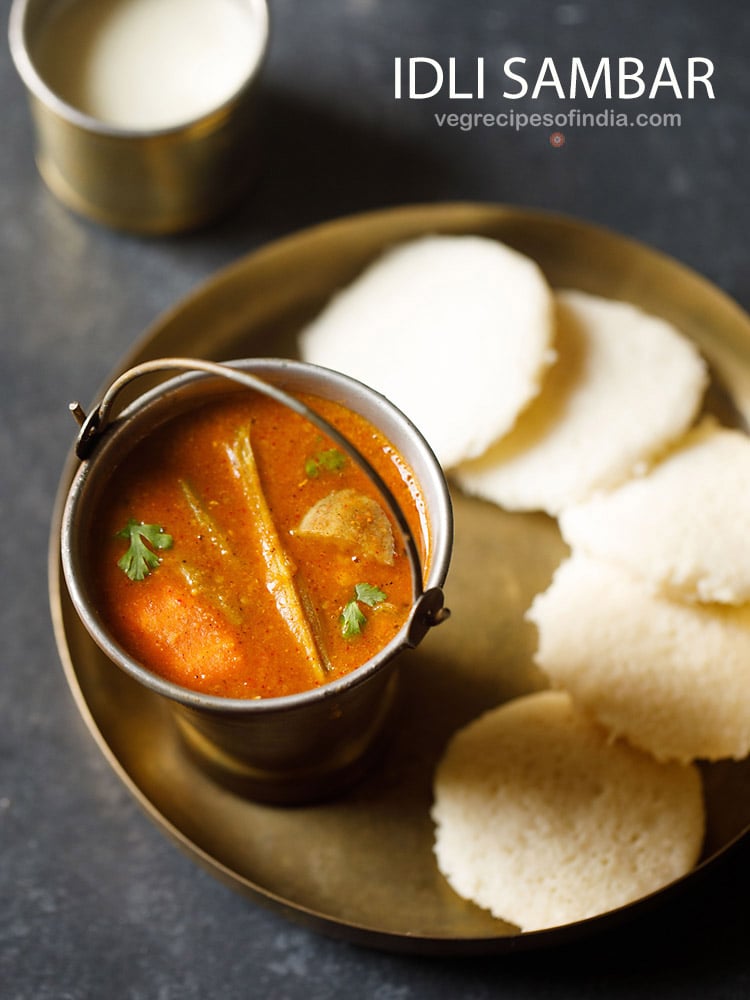
About Idli Sambar Recipe
In the South Indian cuisine there are many ways the sambar is made. I share one such variation which gives you a flavorful sambar like the one served in South Indian restaurants and hotels.
This idli sambar recipe is super tasty and can be served with South Indian tiffin snacks like idli, dosa, medu vada, rava idli, rava dosa, uttapam and pongal etc.
This is also one of the best tiffin sambar recipe. This hotel style sambar tasted damn good with soft and fluffy idlis. Oh yes, idli sambar and vada sambar are all time favorite at home. Not to forget our love for dosa too.
This recipe was shared by a reader friend Priya who writes to me often. She was gracious enough to share her sambar recipe as well as this recipe.
This recipe is adapted from Revathy Shanmugam’s recipe and Priya was kind enough to translate and send me the recipe. I had the good chance of having email conversation with her through a common friend and Revathy ji is a gracious and humble person.
I made some changes in the recipe to suit our taste buds. This dish was loved by the family and so they would ask me to make it again.
Even today I make this sambar to go with idli or medu vada. You can also enjoy this with steamed rice for a comforting meal.

Planning & Cooking Tiffin Sambar
1. Some preparations and planning in advance are required if you want to make idli sambar for breakfast. So make the idli batter and ferment it in the previous afternoon or late evening (for winters) or night (for summers).
2. When the batter is fermented the next day, you can steam idli when you pressure cook the dal and cook the veggies in a pot or pan. I usually pressure cook lentils first. Then roast the spices and make the sambar powder from scratch.
When the lentils are cooking, I steam the idli and keep them stored in a casserole so that they stay warm. After making the tiffin sambar powder, I cook the veggies and then make the sambar.
3. On busy mornings, you can make the sambar powder a day before and refrigerate. Next day cook the lentils and veggies. Then make sambar.
4. For making idli sambar, you can either make small mini idli or the regular sized idli. Both taste good.
5. While serving idli sambar make sure the sambar is hot. The idli can be hot or warm. If the idli have turned cold, then sprinkle some water on them and warm them in a frying pan covered with a lid or in a microwave oven.
6. To make idli you can check my fail proof recipes
- Idli recipe – soft idli recipe
- Rava idli – quick and easy idli variety made with sooji or semolina
While serving idli sambar you can drizzle a bit of ghee on top. You can also top it with some chopped onions. Also garnish with some coriander leaves while serving.
How to make Idli Sambar
Cook Lentils
1. In a bowl take ¼ cup each of tuvar dal (arhar dal or pigeon pea lentils) and masoor dal (red lentils). You can also just take overall ½ cup of tuvar dal.
As you see in the photo below pigeon pea lentils are yellow colored and they are split and without husk. The red lentils or orange colored lentils are also husked and split.
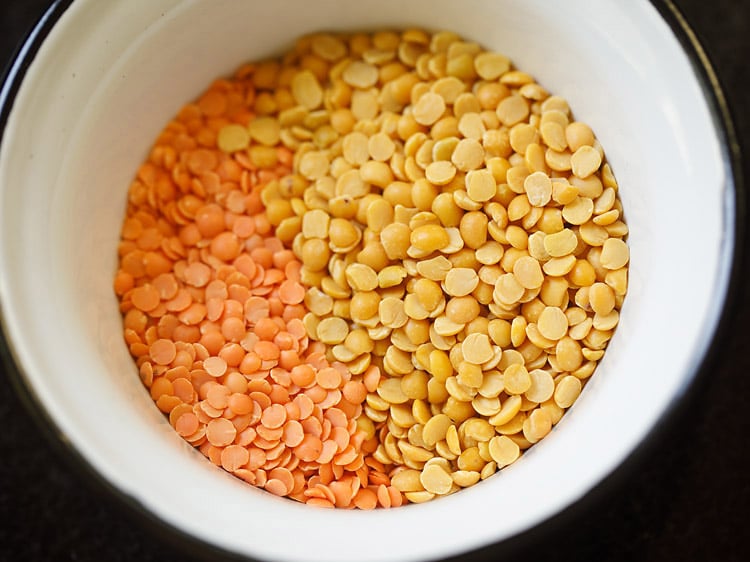
2. Rinse the lentils well in fresh water and then add them in a 2 litre pressure cooker.
You can also cook these lentils on stove top in pan or in an instant pot. If cooking in a pan, I suggest to soak the lentils in enough water for at least half an hour so that they cook faster.
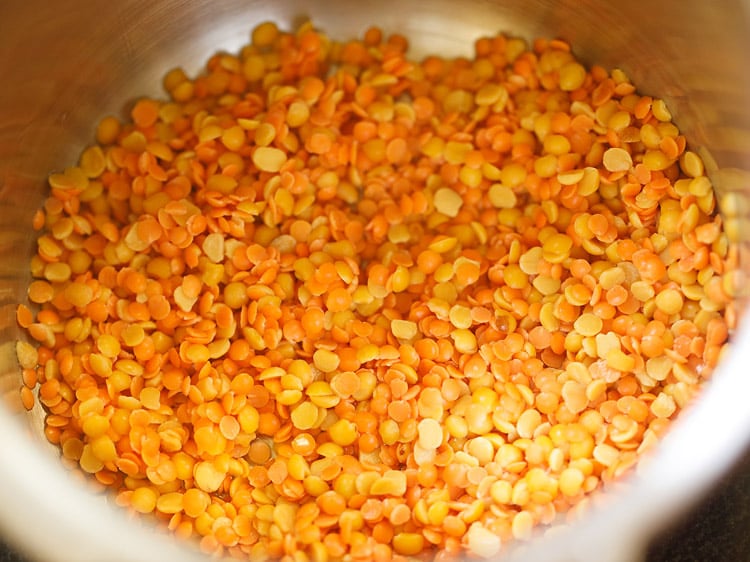
3. Add ¼ tsp turmeric powder and 1.25 to 1.5 cups of water in the pressure cooker.
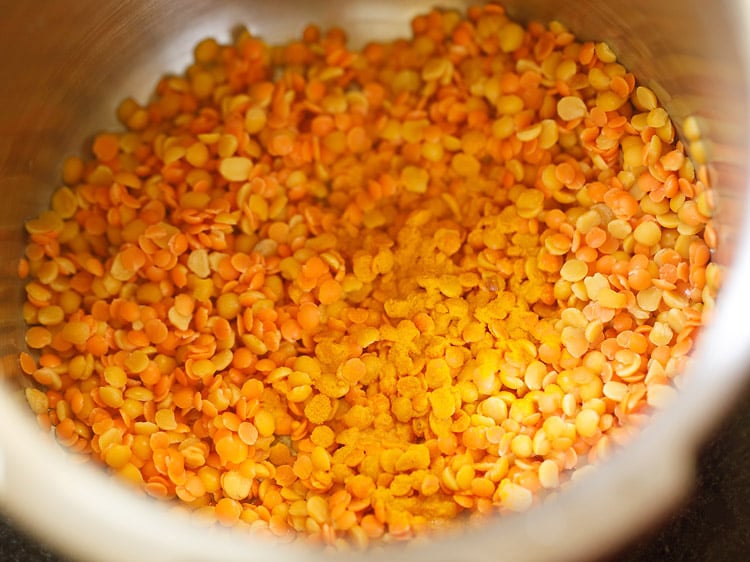
4. Pressure cook the lentils till they are soft, mushy and well cooked for about 7 to 8 whistles or 11 to 12 minutes on a medium flame.
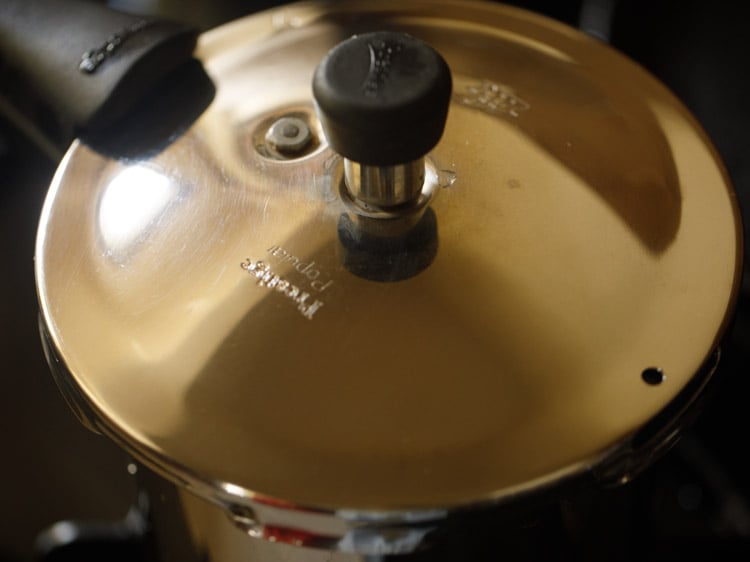
5. Open the lid once the pressure settles down naturally in the cooker. The lentils should have softened very well, so that they can be easily mashed.
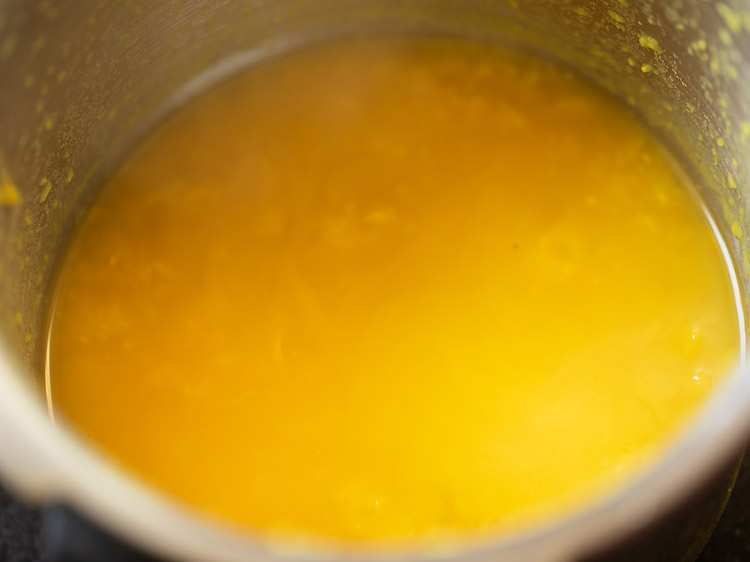
6. Mash the lentils with a spoon or wired whisk and set aside.

Make Tamarind Pulp
7. Take 1 tablespoon tamarind and soak it in ¼ to ⅓ hot or warm water for 20 to 30 minutes.
Tip: If you don’t have dried tamarind then you can use about ½ tablespoons of packaged tamarind paste or as needed.
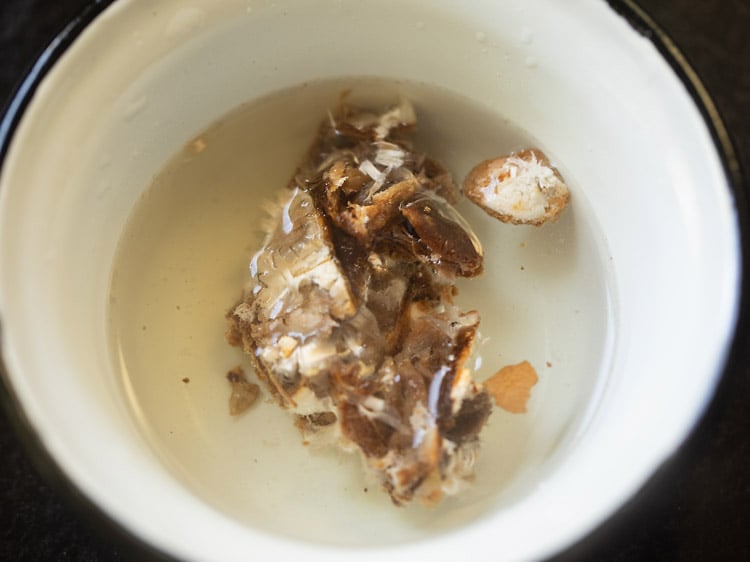
8. Later squeeze the tamarind in the water and you get the tamarind pulp. You can even strain tamarind pulp and keep aside.
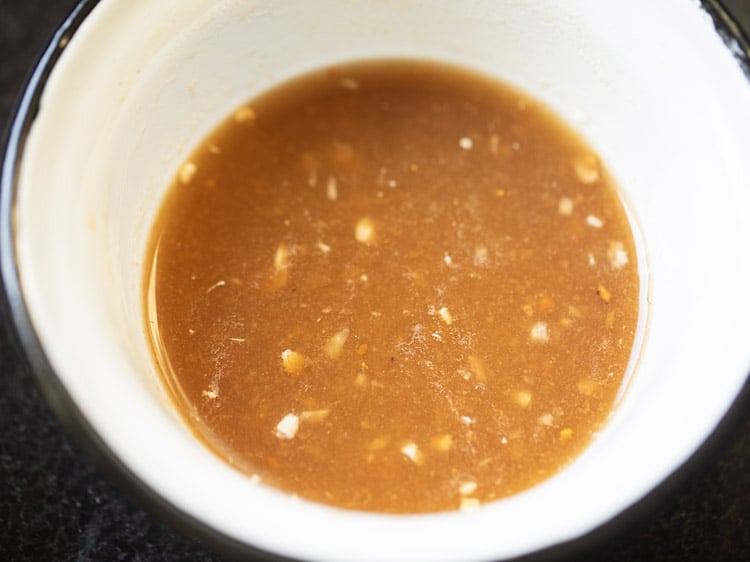
Make Sambar Spice Mix
9. In a heavy small frying pan, heat 2 teaspoons oil. Keep the flame to its lowest. First add mustard seeds. Mix and stir.
You can use any neutral flavored oil.

10. Then add the remaining whole spices – coriander seeds, fenugreek seeds, cumin seeds, black pepper, chana dal (husked and split bengal gram). Mix and stir.
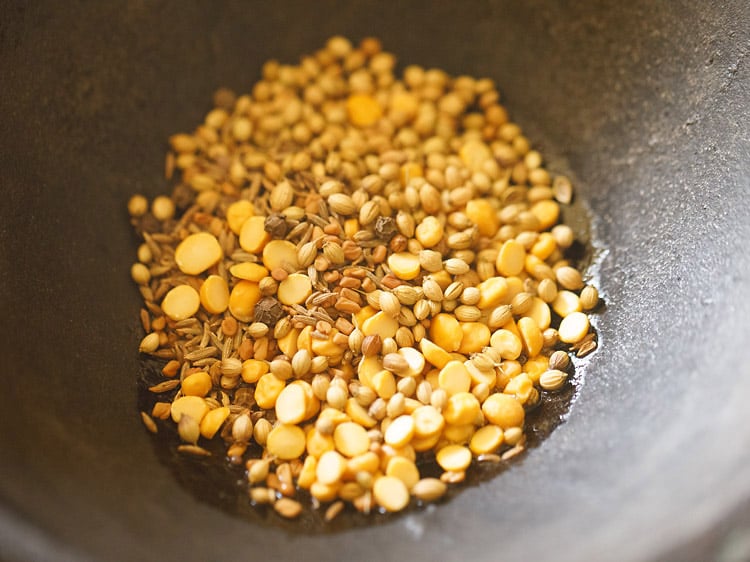
11. Immediately add 5 Kashmiri red chillies or 5 byadagi chilies (broken and seeds removed).
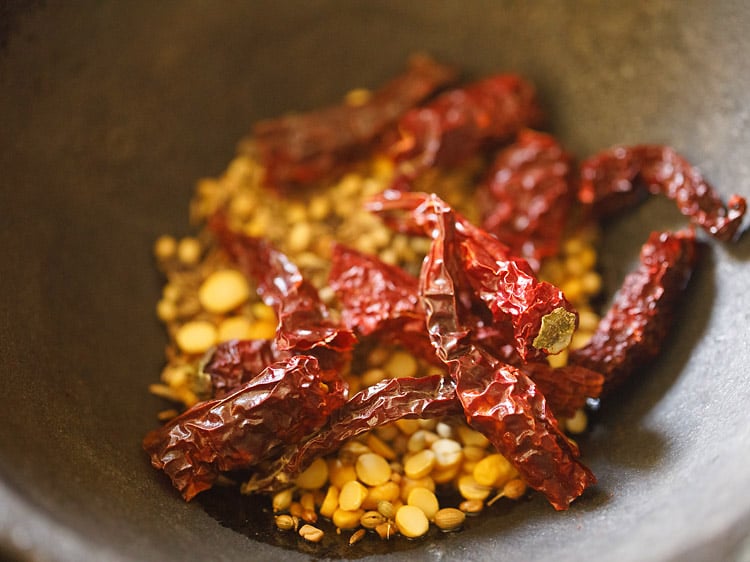
12. Next add curry leaves.
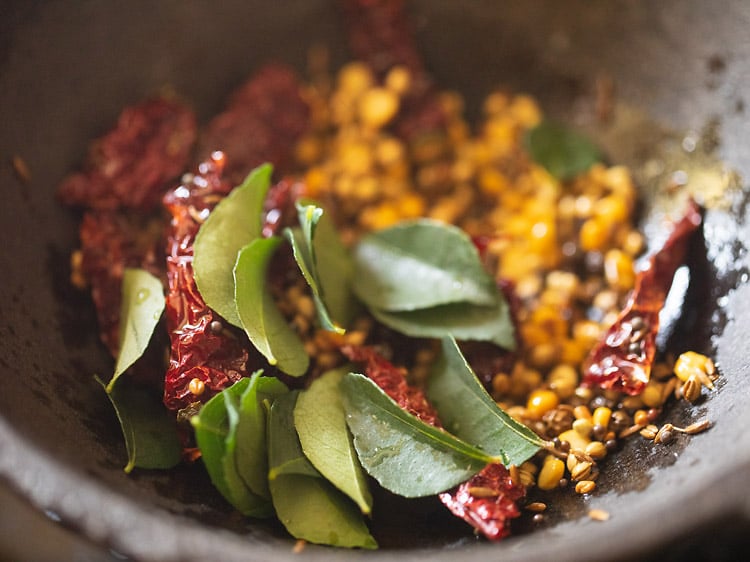
13. Mix very well. On a low heat, stir non-stop and roast till the spices become aromatic. Your kitchen will smell fragrant while roasting these spices. Ensure that you don’t burn the spices.
Once the spices are roasted well, you can also add 2 to 3 tablespoons fresh coconut or desiccated coconut. Mix the coconut and roast for 1 to 2 minutes and switch off the flame.

14. Keep aside to cool.

15. Once the spices cool, grind them to a fine powder in a dry grinder or coffee grinder.

16. Keep the tiffin sambar powder or spice mix aside.
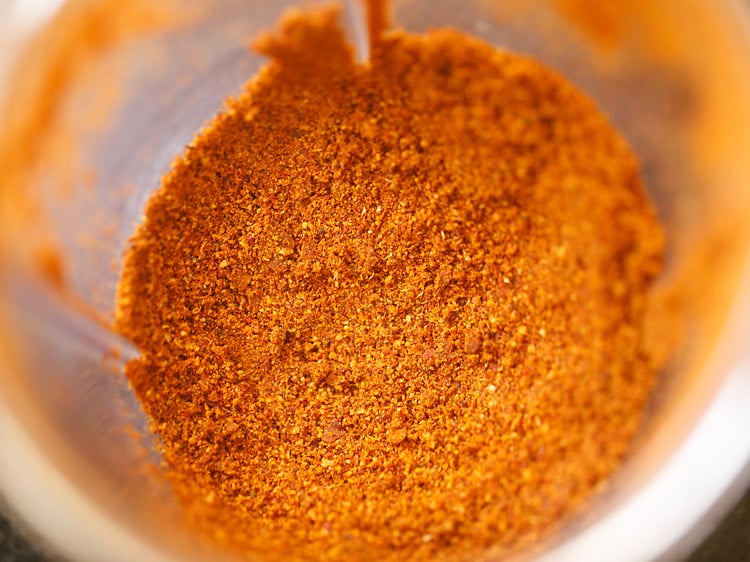
Make Idli Sambar
17. Rinse and peel the veggies. Chop them and keep aside. You can use a mix of drumsticks, carrots, pearl onions, yellow pumpkin, radish, green beans, ash gourd, potatoes, brinjal (eggplant), okra etc.
While cooking just remember to add the veggies that take more time to cook first and later add the veggies which take less time to cook.
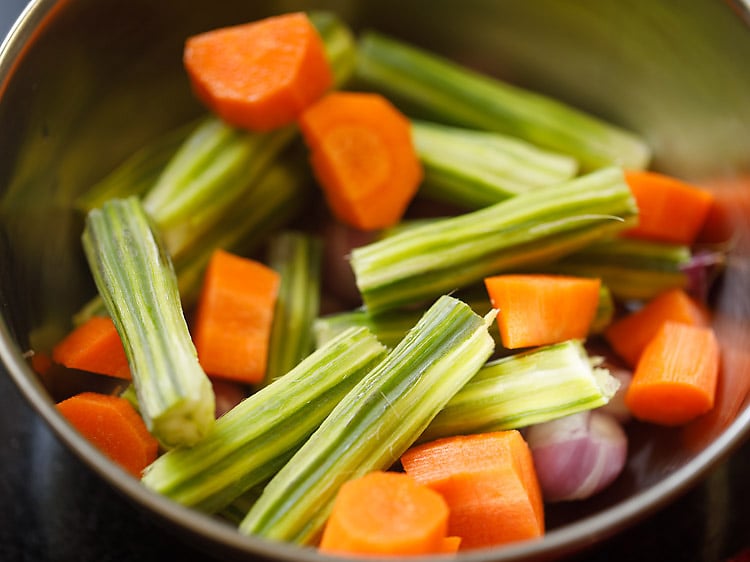
18. For brinjals, chop them and add them to water so that no discoloration occurs.

19. In a pot, heat 2 tablespoons oil first. Keep flame to a low or medium-low flame. Add the mustard seeds and let them crackle.
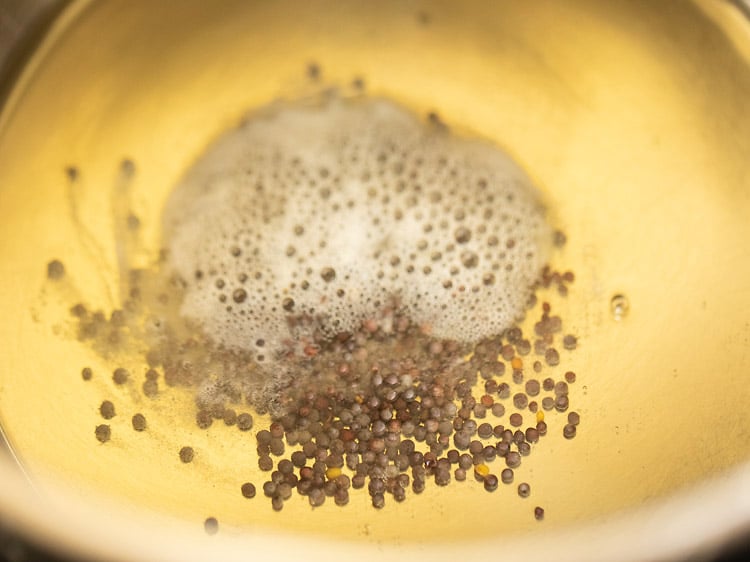
20. Then add the urad dal (husked and split black gram).

21. Let the urad dal turn into a maroonish color.

22. Then add quartered onions or pearl onions (whole or halved), curry leaves and asafoetida (hing).
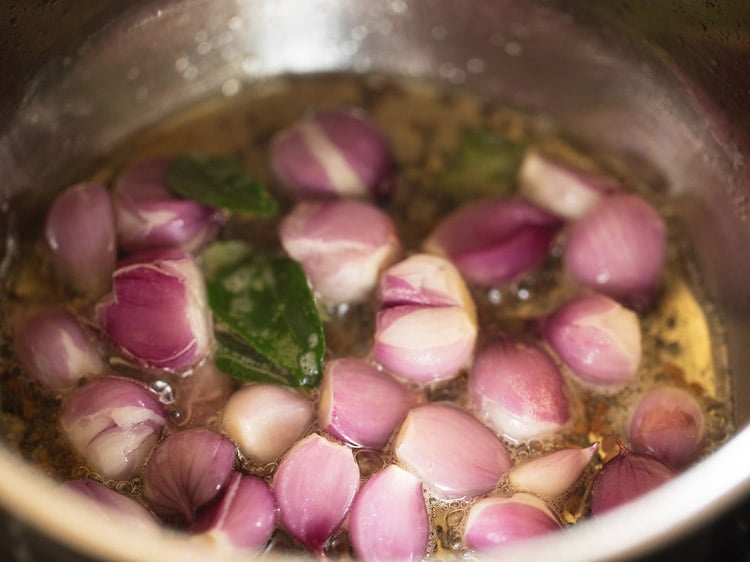
22. Stir and saute for 2 minutes on a medium-low flame.
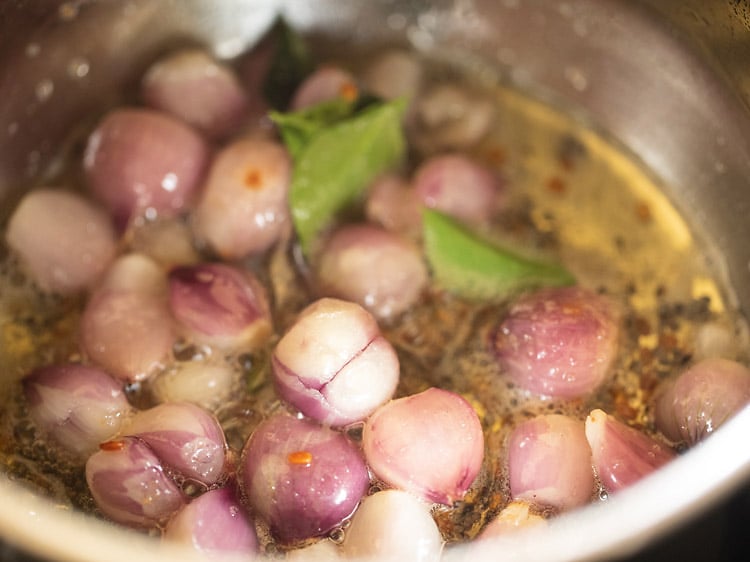
23. Saute till the onions soften a bit.
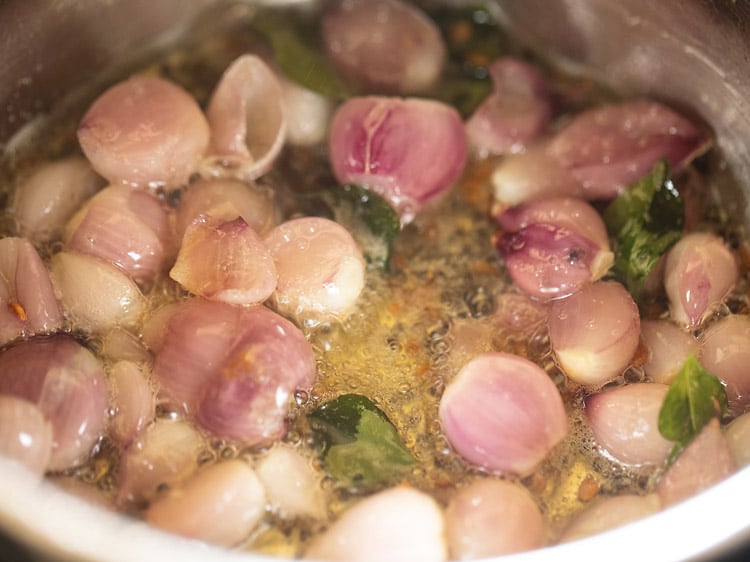
24. Then add the chopped tomatoes.

25. Saute tomatoes for 4 to 5 minutes on a medium-low flame.

26. Next add veggies which take more time to cook like carrots, beans, potatoes, drumsticks etc.
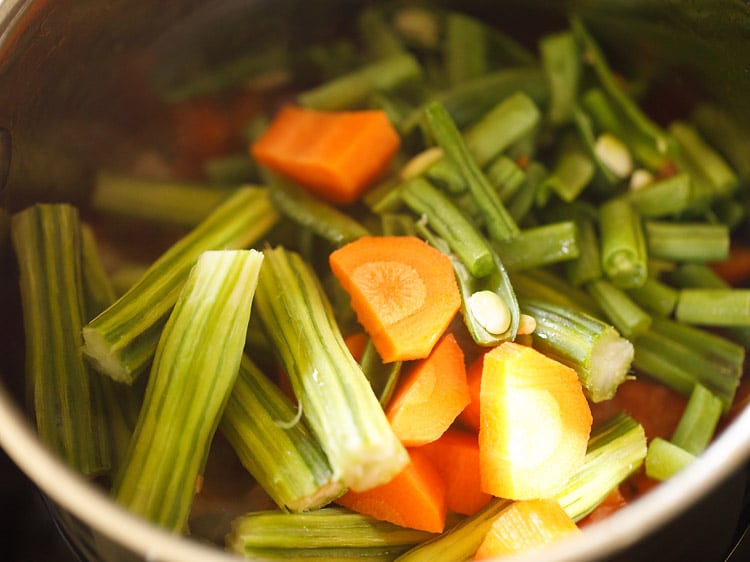
27. Sauté for 4 to 5 minutes on medium-low flame stirring often.
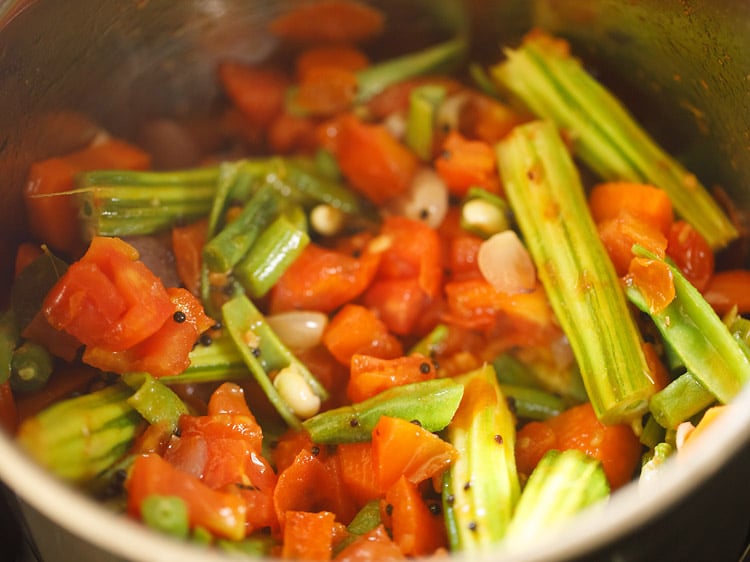
28. Then add remaining quick-cooking veggies like brinjals, ladyfingers (okra), pumpkin etc now. Mix well.
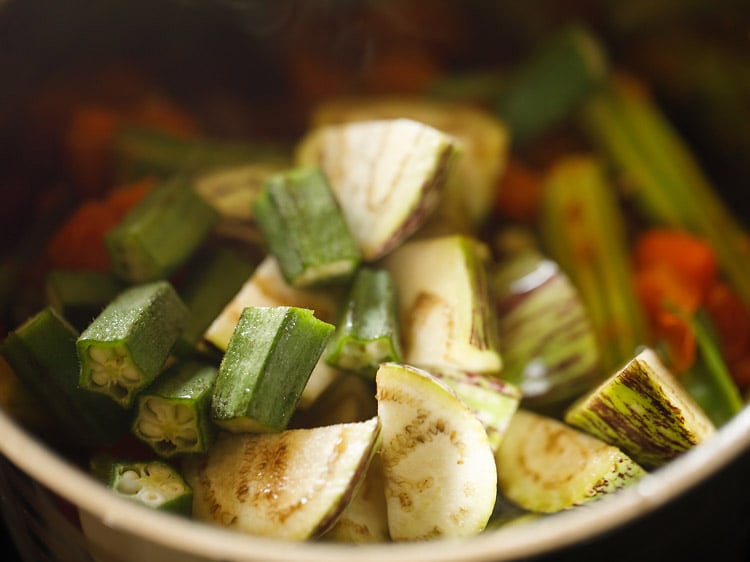
29. Add the prepared tamarind pulp.

30. Pour water.

31. Add salt as per taste and mix well.

32. Cover the pan and simmer on a medium-low flame until the raw aroma of the tamarind goes away and the veggies are almost cooked. If they are undercooked, then continue to simmer till they soften.
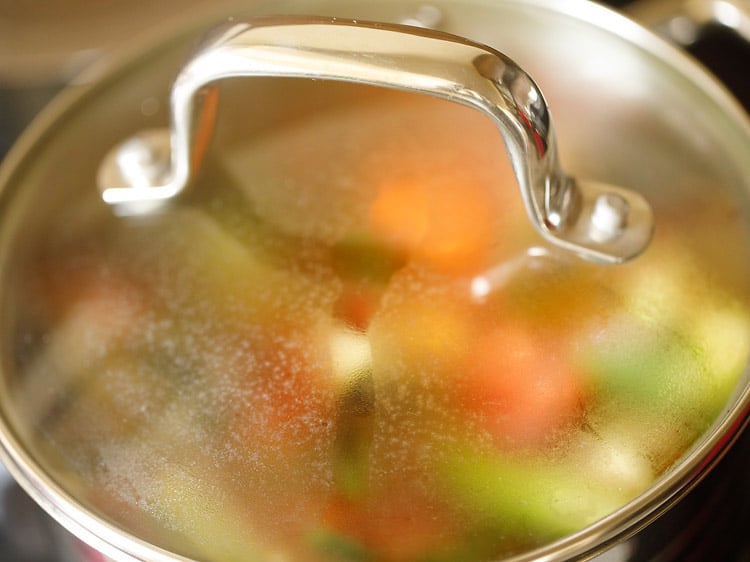
33. The veggies should be almost cooked before you proceed to another step.

34. Add the ground sambar masala powder which we have already prepared earlier.
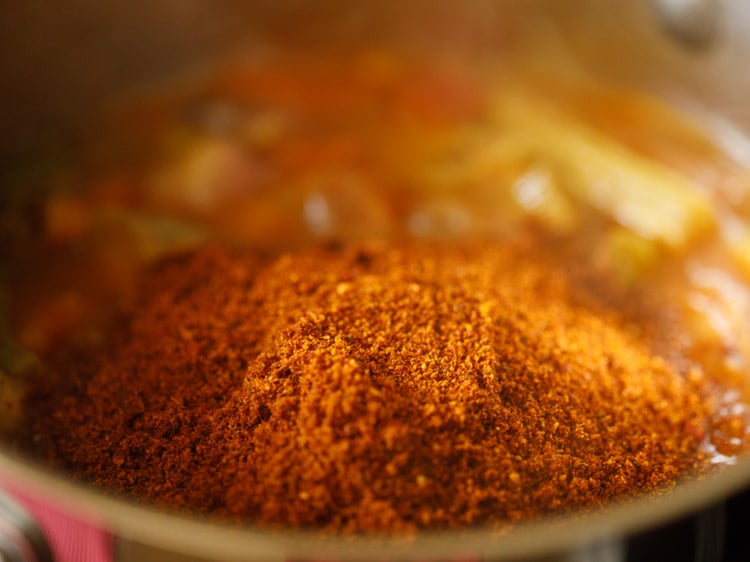
35. Mix very well.
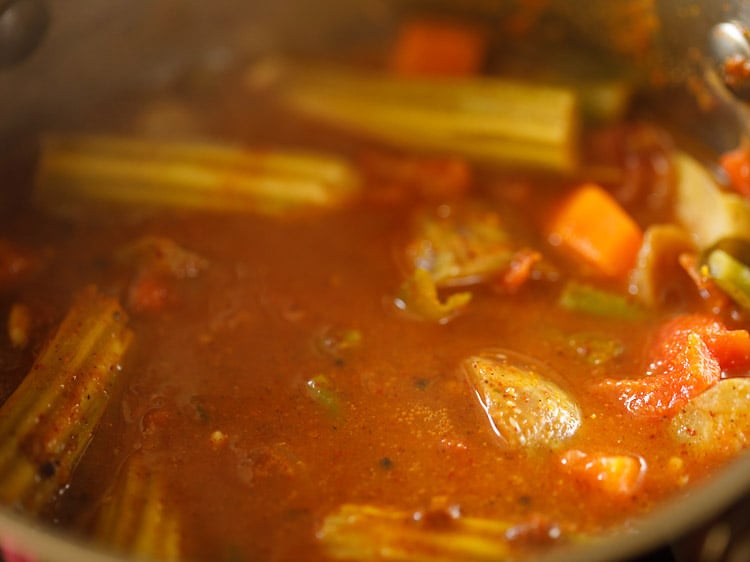
36. Add the mashed dal.

37. Mix again very well. Also add 1 cup water or more to get the consistency you want.
The tiffin sambar served in the hotels is usually thinner. For idli, dosa and medu vada you can keep the sambar having a medium to thin consistency. For serving with rice, keep the tiffin sambar slightly thick.

37. Stir and simmer without lid for about 6 to 7 minutes or till it comes to a boil. Then switch off the flame. Stir at intervals so that the lentils do not stick at the bottom of pan.

38. Meanwhile when you keep the dal for pressure cooking, you can steam idli. Both small-sized mini idli or large idli goes well with this tiffin sambar.
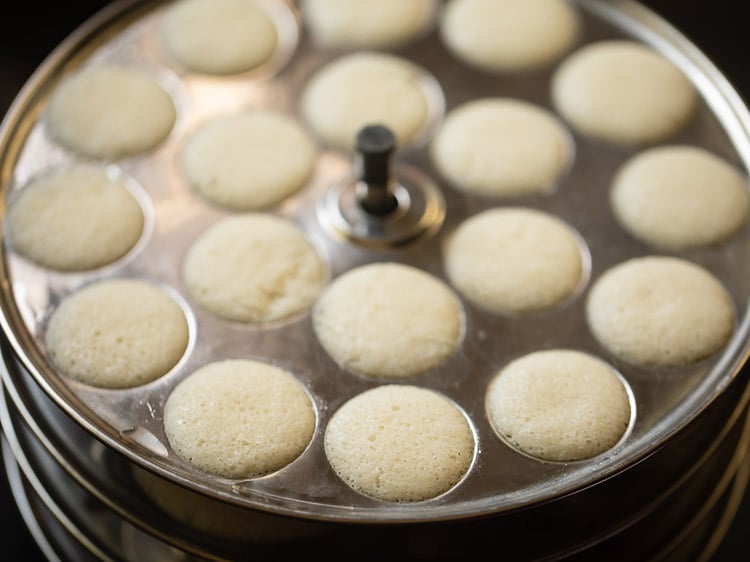
39. While serving place the idli in a serving bowl. Pour sambar. Garnish with some coriander leaves. You can even drizzle a bit of ghee on top. Serve idli sambar hot.
This tiffin sambar can also be served hot with idli, medu vada, uttapam or masala dosa. You can also enjoy with steamed rice.

Expert Tips
1. In the recipe freshly roasted and ground sambar powder is made. This ground sambar powder adds a lot of flavor and taste in the sambar. If you are short of time, then you can use any sambar powder you have and make this recipe. I also make a simple and quick sambar recipe where I add homemade sambar powder. Do note that the final taste of the sambar depends a lot on the type of sambar powder added. So use a good quality sambar powder or use your homemade sambar powder.
2. While roasting the spices for the sambar powder, roast in a heavy pan or a thick bottomed pan on a low flame. Stir non-stop so that the spices do not get burnt. The spices have to be roasted till they become aromatic and golden. Use fresh spices and make sure that they are not rancid.
3. Tomato is one of the key ingredient in this sambar and they add a lot of flavor to the sambar. So please do not skip adding tomatoes. For the veggies, add the ones that are usually added in sambar. Do try to add drumsticks if you can as in most hotel style sambar, drumsticks are added and they give a nice taste & flavor in the sambar. You can also add carrots, green beans, flat beans, ladyfingers (okra), brinjals, potatoes, pumpkin, ash gourd, onions etc.
4. Both tuvar dal and masoor dal are added in the sambar served in hotels. If you do not have masoor dal, you just add tuvar dal. You can also add some moong dal in combination with tuvar dal and masoor dal.
5. Tiffin sambar is usually served with the tiffin snacks – idli, dosa or medu vada. but you can also serve this sambar with steamed rice. Do give this recipe a try next time you make idli, dosa or medu vada or even steamed rice.
More sambar variations
Please be sure to rate the recipe in the recipe card or leave a comment below if you have made it. For more vegetarian inspirations, Sign Up for my emails or follow me on Instagram, Youtube, Facebook, Pinterest or Twitter.

Idli Sambar Recipe (Hotel Style Tiffin Sambar)
Ingredients
For cooking lentils
- ¼ cup arhar dal (husked and split tuvar dal or pigeon pea lentils)
- ¼ cup masoor dal (husked and split red lentils)
- ¼ teaspoon turmeric powder (ground turmeric)
- 1.25 to 1.5 cups water for pressure cooking – for a 2 litre cooker
For tempering
- 2 tablespoons oil (gingelly oil, sunflower oil or peanut oil)
- ½ teaspoon mustard seeds
- 1 teaspoon urad dal (husked and split black lentil)
- 4 to 5 curry leaves
- ¼ teaspoon asafoetida powder (hing)
For cooking veggies
- 1 large onion or 10 to 12 pearl onions or shallots or 90 to 100 grams onions
- 3 medium tomatoes or 220 to 230 grams tomatoes
- 1 to 2 drumsticks – scraped and chopped in 2 to 3 inch pieces
- 1 medium carrot
- 6 to 7 green beans or flat beans – chopped
- 1 medium potato – optional
- 4 to 5 okra – chopped
- 6 to 7 small brinjals (baingan or eggplant) or 80 to 100 grams
- 1 to 1.25 cups water or add as required
- salt as required
For tamarind pulp
- 1 tablespoon tamarind
- ¼ to ⅓ cup warm or hot water
For sambar powder
- 5 kashmiri chilies or byadagi/bedgi chilies or 4 to 5 dry red chilies – reduce depending upon the heat in the chilies
- 11 to 12 large curry leaves or 16 to 18 small curry leaves
- 1.5 tablespoons coriander seeds
- 1 tablespoon chana dal (split and husked bengal gram)
- 1 teaspoon cumin seeds
- ½ teaspoon mustard seeds
- ½ teaspoon whole black pepper
- ¼ teaspoon fenugreek seeds (methi dana)
- 2 teaspoons oil (gingelly oil, sunflower oil or peanut oil)
Other ingredients
- 1 cup water to be added later or add as required
- few coriander leaves for garnish
Instructions
Cooking the lentils
- Rinse both the lentils well and then add them in a 2 litre pressure cooker with 1.25 to 1.5 cups water and ¼ tsp turmeric powder.
- Pressure cook the lentils for 7 to 8 whistles or 11 to 12 minutes until the lentils have softened and well cooked.
- You can also cook the lentils in a pan on a stove top or in the instant pot. I recommend to soak the lentils for about 30 minutes in enough water prior to cooking them in a pan. This helps in the faster cooking of the lentils.
- Once the pressure settles down naturally in the cooker, open the cooker. Mash the lentils with a wired whisk and spoon. Keep aside.
Making sambar powder
- In a small and heavy frying pan, heat 2 teaspoons oil. Keep the flame to a low. First, add the mustard seeds.
- Then add the coriander seeds, cumin seeds, black pepper, chana dal (bengal gram), fenugreek seeds, curry leaves and dry red chillies.
- On a low flame stir non-stop and roast till the spices become aromatic and golden.
- Keep aside to cool. Don’t burn the spices.
- Once the spices cool, grind them to a powder in a dry grinder or coffee grinder. Keep aside.
Preparation for idli sambar
- Soak the tamarind in warm water for 25 to 30 mins.
- Later squeeze the tamarind in the soaked water and extract the tamarind pulp. You can strain tamarind pulp and keep aside.
- Chop all the veggies. Quarter the onions or halve the pearl onions. Peel and dice the carrots and potatoes.
- Dice the brinjals and add them in water to prevent discoloration.
- Chop the tomatoes in small pieces.
Cooking veggies
- In a pan, heat oil first. Add the mustard seeds and let them begin to crackle. Then add the urad dal and sauté till they turn to a maroonish color.
- Add quartered onions or halved pearl onions, curry leaves and asafoetida. Stir and saute for 2 minutes till the onions soften a bit.
- Add the tomatoes, salt as required and continue to saute for 4 to 5 minutes on a medium-low flame.
- Then add the veggies which take a longer time to cook (carrots, beans, potatoes, drumsticks etc) and saute for 4 to 5 minutes on a medium-low flame.
- Then add remaining quick-cooking veggies like brinjals, ladyfingers (okra), pumpkin etc now. Stir and mix.
- Add the tamarind pulp and 1 to 1.25 cups water.
- Season with salt as per taste. Mix well.
- Cover pan and simmer until the raw aroma of the tamarind goes away and the veggies are almost cooked.
- If the veggies are undercooked, then continue to simmer till they are almost cooked.
Making idli sambar
- Add the ground sambar powder which we have already prepared. Mix well.
- Add the mashed dal.
- Add 1 cup water or as required depending on the consistency you want. The sambar which is served in the hotels is on the thinner side. For idli, dosa and medu vada you can keep the sambar having a medium to thin consistency. For serving with rice, keep the tiffin sambar slightly thick.
- Stir and simmer without lid for about 6 to 7 minutes or till it comes to a boil. Stir at intervals.
- Check the taste and add more salt if required.
- Meanwhile when you keep the dal for pressure cooking, you can steam idli. Both small-sized mini idli or large idli goes well with tiffin sambar.
- While serving place the idli in a serving bowl. Pour sambar. Garnish with some coriander leaves. You can even drizzle a bit of ghee on top. Serve idli sambar hot.
- You can also garnish with coriander leaves and serve hot with medu vada, idli, dosa, uttapam or even with steamed rice.
Video
Notes
- You can add your choice of veggies.
- This recipe can be halved or doubled too.
- Instead of tuvar dal (pigeon pea lentils), you can also use a combination of tuvar dal and masoor dal (pink lentils). Even moong dal can be used.
Nutrition Info (Approximate Values)
This Idli Sambar Recipe from the blog archives was first published on May 2014. It has been updated on December 2024.
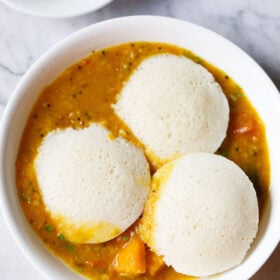
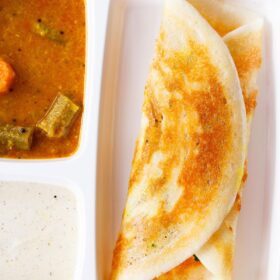

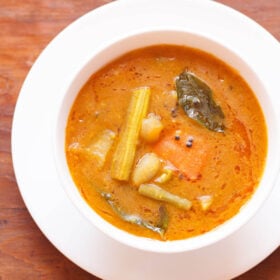









I’m a huge fan of idli, so i’m very happy I founf this recipe. Thank you so much!
one of my favorites 🤩 thank you, Dassana
It is good recipe by Dassana Amit
thanks.
Hello Dear,
I was thinking to write from long time… but finally I decided that I will write today..
One of the top The Best site I ever come across till now…
This sambar is so tasty that one of my frnd is using this recipe in their restaurant…
I just follow your recipe and it will be hit…. thanks a lot….
And most good thing in your site is your response for every comment… helps me to know how exactly will it be…..
I cant praise you enough…. thanks alot again….
Regards,
Shreya.
thank you shreya for such a lovely and encouraging comment. it feels good when i get to read comment like yours and does encourage me to share better recipes. thanks again.
Hi
I prepared sambar…. It’s too good… Thank you for the recipe….. Can we prepare and keep masala powder in large quantities like 250gms……. In that case… How to prepare… Is there any taste difference?
thank you nalina for this feedback on sambar recipe. of course you can make the masala, but keep in fridge. just double or triple the proportions to make sambar masala. taste will be same. prepare sambar the same way as you have made this one. any query you can ask me.
Hi Amit..recently I tried your veg cutlets it turned good and yum off course as always … Am going to try this today evening… I wana knw u mentioned to pour some water in step 14 but how much to pour a cup or more than that.. And u suggested not to use onions if fasting ?? .. Thank you plzz reply soon
thanks fazila for the feedback on veg cutlet. for adding water in the sambar, i have mentioned the amount in the ingredient list. its 1 cup water to be added later once you add the dal. you can add less or more water as per the consistency you want. onions can be skipped if fasting as per the hindu customs. so it becomes a no onion no garlic satvik sambar.
Great recipe. Excellent explanation and wonderful guidance for newbies like me. Turned out amazing. No more $15 dosage trips. Thanks n cheers mate.
Thanks Vik for your positive feedback. Glad to know that you like the sambar recipe presentation.
Thank you Dassana for your wonderful recipes. I tried the sambhar today it came out really well.I am just following your blog for almost all the recipes.
thank you sumalatha. i am glad that the idli sambar recipe turned out very well. thanks for sharing your feedback. happy cooking.
thanks for this perfect recipe. i wont be going to a south indian restaurant for idlli sambhar any more
Welcome Kirti
Can you tell me what type of tamarind you use? Here in North America, in my local grocery stores, I can find the following: tamarind concentrate (the blackish brown shiny pulp), tamarind in the brown shell (looks like a large worm with a crispy black shell, with stringy material and large seeds inside), tamarind paste (comes in a rectangle tray, the tamarind is compressed into a large 1 inch thick rectangle which can then be easily torn into pieces).
When you ask for a tablespoon of tamarind, what type is it? I have been using the paste, which I soak in boiling water in a bowl and strain out stringy fibrous material and some peels, not too many seeds. It seems to work well. Would you be able to send a photo of what the tamarind looks like when you buy it in the store? Apart from that, all other ingredients are available locally.
I love your recipes!!!!
Thanks Anita. It is tamarind which is dried. its not a pulp or paste. it is this tamarind which is shown in step by step photos also – https://www.vegrecipesofindia.com/wp-content/uploads/2014/05/hotel-style-tiffin-sambar-recipe5.jpg
Hello I tried this recipe and oh gosh it was finger licking good. You are just amazing. More talented than any other chef i guess. Lots of love.
Thanks Deeksha for your kind words. Glad to know that you liked the sambar recipe.
Hi Dassana,
Can I make this sambar using just toor dal?
archana, of course. its not compulsory to add both dals.
Dear Dassana,
Tried dis recipe,it ws yummilicious..Ur food blog hs made my life so simple.i hv tried so many of ur recipes n all turned out so tasty n almost perfect. Nw my husband says tht v dnt hv d need to go any restaurant ☺️.Thank u so much
thats a lovely feedback from you tomcy. thanks a lot. this tiffin sambar is also a favorite at home.
It came out wonderful-kids loved it! Also used lauki in addition to brinjal!
thats nice. thanks for the feedback.
Thank you for such a detailed recipe. Can we replace brinjal with other vegetables?
you can skip brinjal if you do not have them. or else you can also add lauki (bottle gourd), pumpkin, drumsticks.
I have tried your palak paneer recipe.. it’s good ..thanks for the recipe ..
welcome and thankyou kavitha 🙂
You have made so many of our lives simple. Thanks a lot and God bless!!
thats a beautiful comment, raksha. thanks a ton and wish you all the best.
If you are looking for a good recipe of idli sambar, then look no further. It tastes awesome with mini idlis when drizzled with hot ghee. While serving mini idlis, place them in a slightly deep serving bowl, dunk them in a liberal amount tiffin sambar, drizzle melted ghee and garnish with fresh coriander leaves. Your kids will relish it and so will you.
thankyou for sharing this 🙂 sedbaron.
Hello,
Tried this recipe and it was simply awesome. We ate it with rice too and it was pretty good. Thanks for sharing such wonderful recipes again!
thank you neha. this recipe has become a staple at home and is even our favorite.
This turned out to be a great hit at home! Thank you so much for all your wonderful recepies
thanks and welcome karishma.
i love this food
thankyou riya 🙂
interesting recipes.
thankyou riya
Hi,
How much is 1 tbsp Tamarind… Is it Lemon size or gooseberry size?Do we have to add all the grounded sambar Masala to the above recipe? And I would like to know if I can simply double the recipe if am doing for 10 ppl?
gooseberry size but one which is smaller than a lemon. yes the entire sambar masala needs to be added. you can double the recipe i think.
We don’t hve masoor dhal wat cn v do?
abi, then you can try with moong dal or use only arhar dal.
Hi Amit, I made this sambar (1) today together with your coconut (2) and coriander (3) chutneys too. I used an instant store bought mix to make idlis and dhokla to see if I could cheat a little at least. Well suffice to say I won’t be using an idli instant mix again! Dhokla was actually quite good but more because I used your tempering (4) recipe.
(1) was simply fantastic. The highlight of the recipe has got to be grinding your own masala; I did it by hand in a stone mortar and pestle. The aromatics were superb and my kitchen has never smelt so authentic. I didn’t use brinjal but put in slightly more potatoes, carrots and tomatoes. My wife came home, ate the dhokla at tea time and said she wouldn’t be eating dinner as she wouldn’t be hungry. Well, after she tasted the sambar and the chutneys she ended up eating dinner like a soldier. So thanks very much for taking the time to put this up online. May I ask though, why does the masala go in so late and not earlier?
(2) and (3), were excellent accompaniments though I think I have to be careful to ensure the lemon I use is sour enough. Here in England the lemons aren’t as sharp as they should be.
(4) was authentic too and tasted like a pukka Gujarati made it.
All this of course means my local Kerala and Gujarati restaurants won’t be seeing me anymore!
All the best. Rohit.
thank you very much rohit for this lovely comment. i was smiling reading your narration. the idli and dosa mixes are not good. i have tried them when i was in a corporate job, working full time, to ease the their preparation time at home. but not like the ones we make at home. but rava idli is still better. even dhokla is good. the masala goes late as we have already sauteed it in the oil and its cooked to some extent. so we don’t need to add it earlier. thanks again.
Reference the masala, yes that makes sense and apologies in case I mixed up your first / last name? I tried idli batter yesterday, nightmare! I used 1/2 cup urad, 1.5 cups basmati and some fenugreek seeds. Washed and soaked for several hours then blended all together with enough water to make a paste. It was only 20 C degrees here during day so colder in night, so I put in Pyrex dish with lid in oven with pilot light on overnight. Ready for idlis in morning but no chance. Batter hadn’t risen. So oven went on at 95 degrees farenheight. A few hours later it had fermented and risen but just didn’t look right. All the water had been absorbed and mixture looked a little cooked. Salvage operation meant adding salt and mixing with spoon plus water until batter like consistency. Then steamed in idli maker for 15 minutes. Idlis tasted good but the texture was granular, a little incoherent and basically un-idli like. It would have fed babies very well. I then used remaining batter for uttapum which actually were good enough for feeling mildly proud if prior experience with idlis hadn’t taken place. It’s going to take practice and experimentation! Next time, I think I’ll try poha, idli/par boiled rice etc instead of basmati. I’ll also blend for a lot longer and may be put in a preheated oven to only ignite the reaction initially then revert to pilot light. Finally, I think even the amount of water I put into idli steamer may need careful thought. Or…..I could just move to Kerala and invoke the idli gods to bless my batter!
Just read your idli batter recipe ?. Will follow to the letter before invoking the Idli God.
thank you and all the best 🙂
fine. i guess the idli batter kind of cooked in the oven. thats why it looked like the water had been absorbed. the granular texture is also due to the fact that the slightly cooked batter getting mixed with water and then again getting steamed. making the batter takes practice. and in cold climates, it does take time to ferment. i would suggest to use a large casserole for the batter (allowing space and volume when the batter triples) and then wrap it with a warm kitchen towel and keep in the lighted oven. you can also keep the batter during daytime near a window sill or balcony to get some light from outside. the oven can be preheated but at lower temperatures like 80 degrees celsius. then switch off the oven and keep the batter. with practice the idli gods will bless you 🙂
Thanks for the advise. I wonder why we simply don’t use yeast or baking powder? What are the pros and cons of using some kind of agent to ingnite the fermentation and rising?
of course, you can use yeast. i forgot to mention in the previous comment. a couple of times the idli gods have been unhappy with me during winters. so after keeping the batter overnight, just 30 to 45 minutes before steaming, i add 1/2 tsp instant yeast. i dissolve them in a tsp of water and then add. cover and allow the batter to leaven. after 30 to 45 minutes, you will see nice bubbles in the batter. but with yeast the issue is that the batter keeps on getting leavened. if you keep the batter in the fridge, then it gets too much leavened, fermented and the yeasty aroma can be felt distinctly. so when i add yeast, i try to use all the batter in one go. with baking soda its better to have an acidic ingredient. like 1 tbsp to 2 tbsp of curd mixed with the batter. but with baking soda, the batter has to be used immediately for making idlis. the same rule applies to eno/fruit salt.
Excellent advice again. I knew there would have to be some reasons why we all can’t simply cheat!
Dear Dassana,
The sambar turned out just amazing! Delecious! All the best to you n your husband for all the handwork you do, compiling the recipes with such beautiful simplicity. Keep up
The good work and I Look forward to your recipes, always.
thanks suruchi for sharing your encouraging feedback.
Thanks Dassana for your reply. I get it just because it’s quick one pot method thats why you are adding boiled dal with veges. How about if we just boil the dal(raw) and veges(raw) together you think that would be good ,please advise, thanks
welcome simmi. if you boil and dal veggies together, by the time the dal cooks, the veggies will become too soft and mushy. they can be mashed easily. so avoid cooking both veggies and dal together.
Hello Dear Dassana
Your vegetable sambar recipe and tiffin sambar recipe really looks delicious. I will try definitely vegetable Sambar . However I have one question on vegetable sambar as If you have already boiled dal in pressure cooker then why are you boiling it again with vegetables. Can I avoid boiling it again with veges or would it make some change to taste please advise, thanks
welcome simmi. because this is a quick one pot method. if you want then you can remove the dal and don’t cook it again.
I made this for dinner today and it turned awesome.thanks for the beautiful recipe.
Whenever i want some receipe first i check just your site.
welcome khanjan. glad to know this.
The best recipe! My husband relished it
thanks nandini for sharing positive feedback.
Recipes are very nice, recipe with step by step along with picture of recipe is very good to understand the method of the particular recipe, thankyou
welcome anunitha. thanks for sharing positive feedback.
thanks for this recipe, sambar tasted very awesome, me and my elder sister love it.
welcome siciliya. glad to know this.
had made sambhar before but it never tasted so good. i added a few more vegetables and followed the steps exactly…..hmmmm very tasty. thanks
welcome jitu. glad to know this.
Hi Dassana
i made this for lunch today and it turned awesome.thanks for the beautiful recipe. Can u post koli masala ingredients. I have heard its very tasty bt u dnt get it at calcutta.
thanks sunita
thanks and welcome sunita. i know of of a food blogger who prepare koli masala and delivers it. i have not used it, as i do not make sea food. but a few blogger acquaintances have given good reviews. you can check the link here – http://www.annaparabrahma.com/Koli-Style/Koli-Masala-250gms-id-862875.html
Hi Dassana,
Wanted to know that while grinding the sambhar masala, should the curry leaves be ground or should I discard them after tempering?
Awaiting a reply soon.
kunj, you have to ground the curry leaves.
Your recipe is good mam. But I have one doubt, we South Indians generally wont grind the mustard seeds. If we do so, they’l say that it will change the taste. Can we do so?
thanks dharani. if you want then skip grinding the mustard seeds. this is a south indian recipe only. there are many ways of making a recipe. thats why the difference.
awesome sambhar …siimply mouth watering. … previously I was using achi sambhar powder but after making this shifted to yours recipes .. I just wanna ask can I keep this masala in air tight container and how long ??
thanks meeta for sharing positive feedback on sambar. glad to know this. you can store it for more than a month.
Hey Dassana.. Can i use Badshah Sambhar Masala instead?
sneh, you can use but taste will be different. i suggest to follow this recipe.
Thanks for the recipe….i followed the same procedure as you mentioned result was a tastey sambar.
welcome manjushree.
It is an awesome recipe. Got a lot of compliments when guests had it. Five Stars.
thanks suresh
Great recipe! I had a coffee grinder handy and was able to make the masala from scratch……I just added my own twist of a crushed garlic clove and one green chilli……..but overall best sambar I had in over a year 🙂
thanks ankita for sharing your positive feedback on tiffin sambar. good to know your variation.
Excellent demo. Thanks.
welcome krishna
Can I use dry curry leaves in any part of this recipe? Or only fresh? Thanks!
you can use dry curry leaves to make the sambar powder as well as while tempering.
Hi
Your way of expressing clear instructions with pictures is of great help. I am an occasional writer but a regular cook at home. I have found many recipes from your food blog that have turned out quite well.
Thanks
Reshma krishnamurthy
welcome reshma. thanks for sharing positive feedback on recipes.
Awesome. Truly authentic hotel sambar taste!
thanks rajesh for sharing positive feedback.
Very nice
hi madam,
this sambhar will taste like home made sambhar.
if u add shallots with the tuvar dal and few garlic pieces ,tomatoes it will taste like hotel sambhar.curry leaves and coriander leaves should be added…..
thanks for the tips. but the taste of this sambar was like hotel sambar 🙂
I tried this sambar receipe yesterday… its came out very well…my little one loved this very much.. credit goes to u… thank you.
thanks vidya for the feedback.
Hi Dassana,
The sambhar looks delicious here and I intent to make it this weekend. Can you tell me if I can replace tamarind pulp with lemon juice? Would there be any change in the sambhar?
Awaiting your reply.
Thanks and Regards,
Komal
thanks komal. tamarind gives authentic taste to the sambar and is always added traditionally. no other souring agent will give you that taste. if you add lemon the taste only will change but you can give it a try.
hello dassana madam, I want to make this sambar nearly, please teach me which vegetables can use also?
you can add carrots, french beans, small onions (shallots), tomatoes, bottle gourd (lauki), pumpkin, radish, brinjal (baingan), okra (bhindi), drumsticks.
This sambar turned out to be AMAZING! 5 stars isn’t enough- it truly takes like restaurant style sambar, or if made by someone’s mother. The freshly ground sambar masala really makes a huge difference. I served this along with ven pongal for some guests, and it was a hit all around. 😀 And thank you for such detailed instructions- the cooking times listed helped immensely to make sure that everything was cooked just right.
welcome jaya. glad to know that you liked the sambar recipe. keep trying more recipes from the blog.
Hey I tried this today.. And the sambar was really like restaurant sambar… Love this recipe.. Please also share recipe of spring rolls
thanks for the feedback priyanka. will update the recipe of spring rolls too.
hey dassana i really like your recipies this sambar recipe is too good i tried it its tasty .THANKS I am from Goa
thanks purity for your feedback 🙂 you have a nice name.
hotel sambar with MAAMis sambar masala powder is very delicious.. Tasty with Aroma
SRamakrishnan, thanks for the info.
Hi I want to know how to prepare sambar powder mam
archana, i will be adding sambar powder recipe soon.
Dear Dassana,
Please advise your recipe for sambar powder….is it possible that we can make it and keep using it …or its supposed to be made for every time…..
I also wish you would share your recipe for the white colour coconut chutney that we get at the restaurants……..
hi joyce, i will surely add sambar powder recipe. i do have a stock now which is getting over. once its over, i will prepare a fresh batch and then add a post. you can make the sambar powder in small quantities like 250 grams or in bulk, like 1 or 2 kgs and store it. it can be added to whenever sambar is made. okay, let me see if can post the white color coconut chutney. usually what i do is i grind the coconut with 1 or 2 green chilies and salt.
Hi Dasanna, I just went through your sambhar recipe. Definitely I will go home and try this. Also can you please share with me few recipes like, vegetable pulav, rasam, vangibath, bisibelebath etc. since I am not a good cook and i am not able to satisfy my people with tasty items.
Thanks & Regards,
Nandini.
welcome nandini. these recipes are already posted in the blog. please use Google search button at top right corner of website to search recipes. i hope the recipes will be helpful to you.
I made this sambar today, It turned out really good. Thanks for authentic recipe.
welcome sujata
I just made this sambar and it was GREAT! my favorite sambar recipe yet – thank you so much!
welcome amey
Can we use ready made Sambhar Masala ?
neelam, ready made sambar masala will not give you the exact taste. depending upon on what ingredients have gone into sambar masala, the taste will change.
Hi this is flora,,,just wanted to know can I use (saboot)whole pink lentils….
hi flora, no you can not use whole pink lentils. use 1 cup of tuvar dal (arhar dal). you can even make with mung lentils.
Dassana, this sambhar looks yummy, I am sure making fresh sambhar powder at home adds a lot of flavour to the sambhar.
Will it make any difference if I boil the veggies also with pulses???
Swati
thanks swati. lentils take a longer time to cook than vegetables. so if you cook both together, than the vegetables will become mushy. i would suggest you to first cook the pulses. mash them. and add vegetables and some more water to the mashed lentils. don’t add the sambar masala, tamarind pulp. once the vegetables are cooked, then you add the sambar masala and tamarind pulp. simmer till the raw aroma of the tamarind pulp goes away. and lastly you temper or prepare the tadka and add it to the sambar.